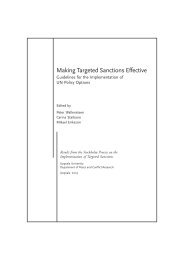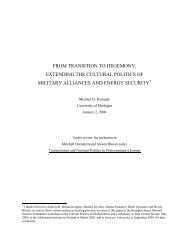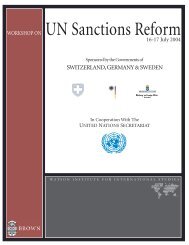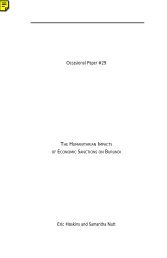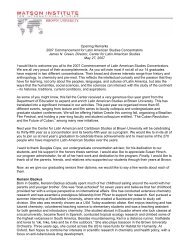How to Think About Civilizations - The Watson Institute for ...
How to Think About Civilizations - The Watson Institute for ...
How to Think About Civilizations - The Watson Institute for ...
You also want an ePaper? Increase the reach of your titles
YUMPU automatically turns print PDFs into web optimized ePapers that Google loves.
closely at the internal debates and conversations among self-identified members of a<br />
civilization about what their civilization entails, and concentrates on the nuances of<br />
those conversations as well as their contentious character. This suggests that<br />
Hunting<strong>to</strong>nian essentialism might itself be composed of the conjoining of two<br />
analytically distinct commitments—commitments that could be accepted or rejected<br />
individually as well as jointly. And that, in turn, suggests a simple categorization of<br />
ways of studying civilizations, a categorization animated by two analytical distinctions:<br />
one involving a turn from static civilizational attributes <strong>to</strong> dynamic civilizational<br />
processes, and one involving a turn from the identification of a civilization’s key features<br />
by scholars <strong>to</strong> an identification of a civilization’s key features by the participants in that<br />
civilization.<br />
I will discuss each of these distinctions in turn, be<strong>for</strong>e assembling them in<strong>to</strong> a<br />
coherent matrix of scholarly positions. 2<br />
Attributes versus Processes<br />
<strong>The</strong> distinction between attributes and processes is a well-established feature of<br />
discussions within scientific on<strong>to</strong>logy. By “scientific on<strong>to</strong>logy” I mean the catalog of<br />
2 I would be remiss if I did not also admit that these distinctions stem, in part, from my own scholarly work and the<br />
value-commitments that drive it. Perhaps someone else looking at the same academic conversation about civilizations<br />
would extract alternative axes along which <strong>to</strong> compare and contrast positions taken up by various participants in that<br />
conversation. <strong>The</strong>y are of course welcome <strong>to</strong> do so, but I’m not going <strong>to</strong> get in<strong>to</strong> the endless exercise of trying <strong>to</strong><br />
anticipate all possible ways of dividing up the conversation—nor am I going <strong>to</strong> try <strong>to</strong> offer any transcendental grounding<br />
<strong>for</strong> the two analytical distinctions that I am proposing. As fascinating as that can be—see (Onuf 1989) <strong>for</strong> a sustained<br />
example—my tastes run more <strong>to</strong> allowing an ideal-typical matrix <strong>to</strong> demonstrate its worth on pragmatic grounds.<br />
<strong>How</strong> <strong>to</strong> <strong>Think</strong> <strong>About</strong> <strong>Civilizations</strong> • P. T. Jackson • Page 9



